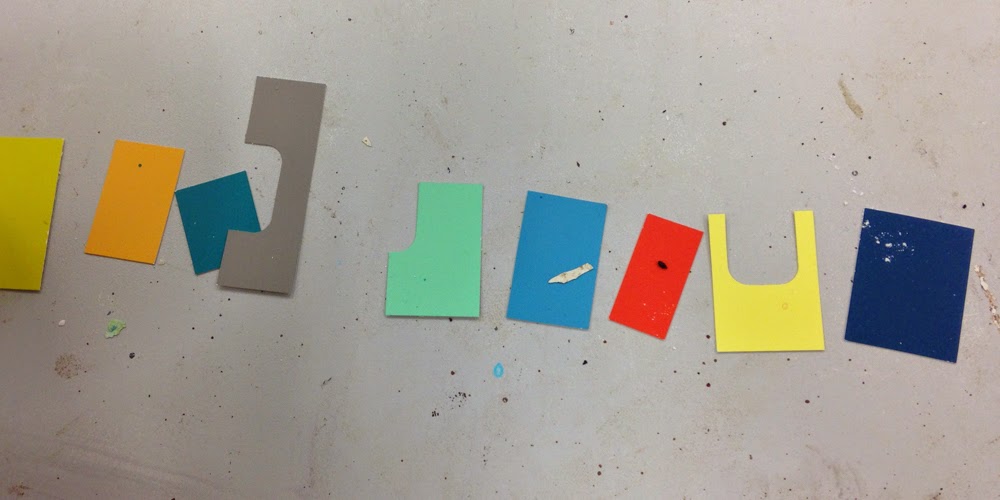The Art Lending Library is a project by Market Gallery and Walker & Bromwich.
The ambitious commission by Zoë Walker and Neil Bromwich takes the form of an experimental library and public procession. Originally conceived and curated by Market Gallery for Glasgow International Festival of Visual Art 2012, it provides the unique opportunity for the people of the town or city in which it is exhibited to borrow works of art and enjoy them within their homes, work places and community centres.
The Art Lending Library brings together over 50 works by a diverse range of artists working across the broad spectrum of formats available within contemporary visual arts practice. The project has been made possible through the generosity of participating artists in gifting their works into the care of the library, to be made available to loan for the duration of the exhibition.
The library structure is made up of multi-functional wooden crates. Each crate houses an artwork and is detachable and ready for transport to people's homes. On returning to the library the crate is re-attached to the body of the library and again operates as a display case. This modular design creates a constantly changing sculptural form that maps the user's borrowing. As people borrow or return an artwork they will also physically shape the library, becoming a part of an on going social sculpture.
The project stands in resistance to the tide of narrowing access to the arts and education by creating an egalitarian space where art can be borrowed and enjoyed by all sectors of society. Art Lending Library follows the model of a public lending library which members of the public can join free of charge.
Following its success in Glasgow, the Art Lending Library is going on tour, and today it was launched in as part of the inaugural East Durham Creates Festival. Here are the details:
Peterlee
Peterlee Memorial Methodist Church 29 Oct – 1 Nov 2014
Thornley
Thornley Village Centre 7 – 10 Nov 2014
South Hetton
Robin Todd Centre, South Hetton 13 – 16 Nov 2014
Artworks from artists based in Durham have been chosen for the Art Lending Library in this venue.
Artists that have been exhibited in Art Lending Library include Penkiln Burn, Graham Fagen, Joanne Tatham and Tom O'Sullivan, Mark Vernon, Ellie Harrison, Katie Cuddon, Henna Rikka Halonen, Oliver Braid, Elpida Hadzi-Vasileva, Mark McGowan, Karen Guthrie and Nina Pope, James McLardy, Stephen Hurrel, Alec Finlay, Laura Eldret, Calum Stirling, Andrew Burton, Laura Aldridge, David Sherry, Chris Biddlecombe, Stuart Murray, David Faithfull, Yu-Chen Wang, Jonathan Owen, Nick Fox, Andros Semieko, Kate V Robertson, Peter Evans, Beagles and Ramsay, Jemima Brown, Ally Wallace, Dean Hughes, Fernando Arias, Salome Oggenfuss, Roos Dijkhuizen, Kevin Hunt, Clara Ursitti, Tessa Lynch, Helen De Main, Sandy Grant, Jasmina Cibic, Pilvi Takala, Razan Akermay, Rachel Maclean, Pester & Rossi, James Stephen Wright, Romany Dear, Jacqueline Donachie and Roddy Buchanan, Tim Savage, Ciara Phillips, Catrin Jeans, Chris Mackenzie, Ross Frew, Ewan Manson, Rachel Barron, Sarah Laing, John Vella, Tom Nolan, Kate Murphy, Deborah Kelly, Michael Needham, Ashley McCormick, Annie O'Donnell, Dryden Goodwin, Gayle Chong Kwan, Iacopo Seri, Juan Pablo Echeverri, Margaret Harrison, Nick Kennedy, Nicky Peacock, Kraig Wilson
Designers Sophie Dyer & Sebastian Gorton Kalvik continue to deliver the design work for Art Lending Library.
The project is accompanied by a programme of free participatory events that are open to everyone.
Being involved in the parade was a really positive, fun and moving experience. A group of students from the Fine Art department at Newcastle University volunteered, and we were kitted out with librarian and art-handler outfits. The procession took us from the Methodist Church where the library is based, along the High Street and through the local shopping centre, leading back to the church.
Some of us were carrying flags, there was an art handler carrying an artwork which was then handed over to a librarian, other librarians were using the crates as drums, and we were handing out the Art Lending Library cards. An excellent brass band brought up the rear of the parade and added a crucial tuneful element to the memorable event.
Having seen the Art Lending Library in Glasgow, back in 2012, I was very keen to be involved in it here, and the experience truly enhanced my appreciation of this wonderful participatory artwork.
Walking down the grim, grey High Street lined by shops to let, value shops and bookies could have been a rather depressing experience, but the Art Lending Library brought a cheer to the streets and it was amazing to witness the light that people had in their eyes when we passed.
I gave a couple of lads some library cards, and a moment later they were helping hand out a bundle of these cards to others as they walked with us to the church.
Already there have been 4 items loaned out of the library, hopefully a sign of things to come.
At the briefing we were given some rather startling figures about the lack of arts and culture provision in this area, and I really hope that having such high quality artwork in Peterlee gives the community a sense of what contemporary art is and can be, and helps create a curiosity and desire for more.
For more information please visit
http://www.artlendinglibrary.org.uk/about/east-durham/






































































